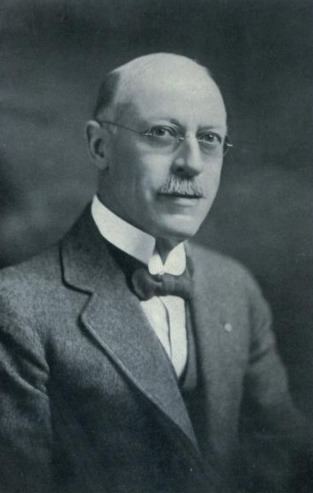Died 22 December 1936 | ||
 | ||
Alexander Frank Wickson (March 30, 1861 - December 22, 1936) was a prominent Toronto architect responsible for the design of numerous buildings including Timothy Eaton Memorial Church, the IOOF Hall (Toronto) and the "Ardwold" mansion for the Eaton family. He was president of the Ontario Association of Architects in 1900 and of the Royal Architectural Institute of Canada from 1918 to 1920.
Contents
Early Life and Education
Frank Wickson was born in Toronto on March 30, 1861 to John and Eliza Wickson. He received his education at Jarvis Collegiate, Upper Canada College and the Ontario School of Art. Following this he became an apprentice at the architectural firm of Smith and Gemmell and lived for a time in Buffalo, New York. He later become a junior member of the Darling and Curry architectural firm.
Architectural career
In 1890 Wickson formed a partnership with Norman Bethune Dick, another Toronto architect as the firm Dick and Wickson. Buildings designed by Dick and Wickson include the original clubhouse for the Royal Canadian Yacht Club and Hazleton Avenue Congregational Church. In 1893 Toronto's branch of the Independent Order of Odd Fellows commissioned a new hall in response to an increase in membership. Dick and Wickson were responsible for the design of the new IOOF hall, which included the first electric elevator used by a society building in the city. Following his partner's death in 1895 at the age of 35, Wickson continued practicing by himself until 1904 when he formed a second partnership with Alfred Holden Gregg as the firm Wickson and Gregg.
Frank Wickson was elected the President of the Ontario Association of Architects (OAA) in 1900. Starting in 1902 Wickson was a delegate of the Ontario Association of Architects to the Canadian National Exhibition. He helped design the exhibition's ground plan in cooperation with Edmund Burke and Eden Smith. Wickson remained involved with the planning of the Canadian National Exhibition until the early 1930s.
In 1911, Sir John Craig Eaton and Flora Eaton commissioned the design of a mansion on Spadina Avenue from Wickson and Gregg which they named Ardwold. This 50-room estate which was one of the most luxurious houses in Toronto at the time and included a pipe organ, conservatory, landscaped grounds and a swimming pool. The house was sold in 1936 and soon after demolished.
Wickson and Gregg was responsible for the design of three Carnegie libraries located in Toronto, Brampton, and Paris, Ontario. Wickson worked with Alfred Chapman in the design of the Toronto library, which is currently the Koffler Student Centre at the University of Toronto.
From 1918 to 1920 Wickson was President of the Royal Architectural Institute of Canada. In this capacity, he led a Canadian delegation to the first Pan-American Congress of Architects held in Montevideo, Uruguay.
Other buildings designed by Wickson and associates include Calvin Presbyterian Church, Berkeley Street Fire Hall (now Alumnae Theatre) and "Haltonbrooke", a residence in Oakville, Ontario for Sir Joseph Flavelle.
Personal life
Frank Wickson married Annie Elizabeth Fisher. They had one son, Carl Jennings Wickson (February 1896 - November 21, 1960). He was an elder at Bloor Street United Church.
Frank Wickson was a member of the executive committee of the Arts and Letters Club, a society for leading members of Toronto's artistic community including the Group of Seven. He contributed articles to Lamps, the club's journal, on the state of architecture in Toronto.
Frank Wickson died at his home on Oriole Road, Toronto on December 22, 1936. His obituary in Lamps referred to him as "an architect of judgment and ability and a man of quaint and friendly humour." He is buried at Mount Pleasant Cemetery, Toronto.
